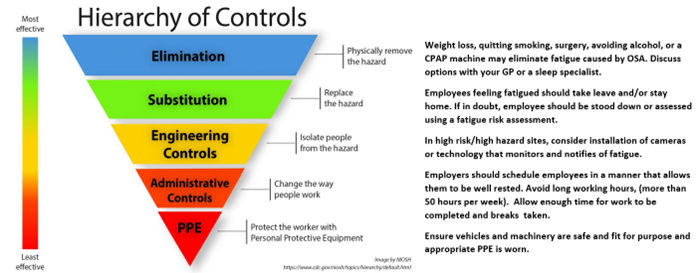Unsilent Night: How Sleep Apnea is Likely Affecting Your Workplace
Claire Arneson
19-09-2022
Obstructive sleep apnea (OSA or mate hoto hau) is a serious sleep disorder. People who have sleep apnea stop breathing for 10 to 30 seconds at a time while they are sleeping. These short stops in breathing can happen up to 400 times every night. This common but rarely discussed condition can add additional levels of risk to the workplace, particularly in the form of fatigue and brain fog. Read on to learn more about OSA and steps you might take to manage this risk in your workplace.
Key points about obstructive sleep apnoea (OSA) from Health Navigator NZ:
- OSA affects about 10% of women and 25% of men.
- OSA is caused by the muscles in your airways relaxing and blocking your airways. You then stop breathing for a short time until your brain wakes you up.
- Obesity is the most common and most important risk factor for OSA.
- Symptoms include snoring, daytime sleepiness, waking up a lot at night or stopping breathing during sleep multiple times.
- OSA is diagnosed through a detailed history and tests, such as a sleep study.
- Treatment can include simple lifestyle measures, continuous positive airway pressure (commonly called a CPAP machine), dental or oral appliances and surgery.
High Potential for Harm
Although it may seem relatively minor, OSA is a serious health issue that can have devastating effects on our roads. For example in 2020 there were 26 fatal crashes, 89 serious injury crashes, and 438 minor injury crashes on New Zealand roads where fatigue was identified as a contributing factor according to the Ministry for Transport.
Fatigue related incidents can have serious consequences for businesses as well. Transport company Freight Lines was fined approximately $90,000 for a 2014 road accident that left the driver with a spinal fracture and a brain injury. It was accepted in court that the tasks assigned to the driver employee in the days leading up to the accident could not have realistically been achieved within the legal logbook/work time limits, yet these were the tasks he had been assigned by the dispatcher.
Identifying the Risk
While employees have an obligation to share any health conditions that might affect their ability to do their job, OSA often goes undiagnosed and unreported to employers. Perhaps this is because snoring (a key symptom of OSA) is often viewed as a comical personal attribute, rather than evidence of a medical condition. In addition, many sufferers of OSA are hesitant to attend a sleep clinic or wear a CPAP mask when sleeping, and they defer speaking with their GP due to these concerns. Other employees fear that disclosure of their condition could negatively impact their job or driver’s license, particularly if they work as a Driver.
Employers can encourage workers to take OSA seriously and seek treatment by providing information, resources, and a non-judgmental approach. Start by educating employees about the symptoms of OSA which include:
- waking up in the morning feeling tired (daytime sleepiness) and groggy
- having early morning headaches
- difficulty concentrating and finishing tasks
- altered mood
- stopping breathing during sleep for 10 seconds or longer (your partner can report this)
- waking up frequently with choking
If left untreated, OSA can take a severe toll on one’s health including:
- poor sleep quality
- poor work performance and work accidents if you have a high-risk occupation, eg, heavy machine operator
- motor vehicle accidents
- short-term memory problems
- depression
- hypertension (high blood pressure), arrhythmia (irregular heartbeat)
- cardiovascular diseases such as heart disease and stroke
- impaired development in children.
Remember that sleep apnea related fatigue is not just dangerous for those operating heavy equipment or driving. Because fatigue (no matter the source) can lead to a reduced ability to process information, memory lapses, absent-mindedness, and underestimation of risk, it can have disastrous consequences for your business in other areas, see below these real-life examples:
- A Payroll Administrator accidentally sent a confidential payroll report to someone outside the organisation.
- A Medical Resident accidentally prescribed the wrong medication to a patient.
- A Recruiter notified the wrong person they were being offered a job with the company.
- The office manager forgot to lock the office overnight.
Although these examples may solicit a laugh, they highlight the importance of managing fatigue across the business.
Reducing the Risk
Employers should control the risks associated with a OSA in much the same way they would address other hazards, through the hierarchy of controls:
For additional information check out the below resources or contact a member of the SBS Team.
Additional resources:
Log Transport Safety Council Sleep Apnea Video: https://logtruck.co.nz/resources/sleep-apnea/
Health Navigator New Zealand – Sleep Apnea: https://www.healthnavigator.org.nz/health-a-z/o/obstructive-sleep-apnoea/
For more information on anything HR or Health and Safety, get in touch with a member of the SBS Team. Freephone 0508 424 723 or email info@safebusiness.co.nz
The Importance of Pre-employment Reference Checking – A Wild Ride of Trust, Truth, and Porkies
Published 04/03/2025
Let’s face it—recruiting a new employee can feel like buying a second-hand car. You’re making a big...
Continue ReadingKids in Cabs – Bringing Children Along for the Ride
Published 04/03/2025
The question of whether children should be allowed to ride in truck cabs sparks strong opinions on both sides of the ...
Continue ReadingHost Responsibility at Work Christmas Parties - A Festive Guide for Employers
Published 19/11/2024
Ah, the work Christmas party. It’s the one event of the year where phone calls, em...
Continue Reading